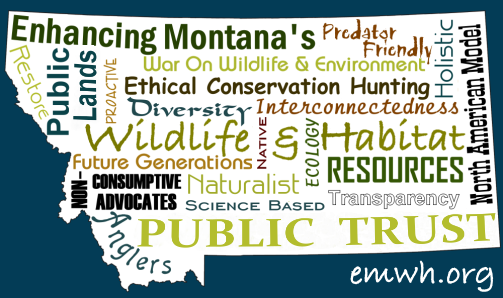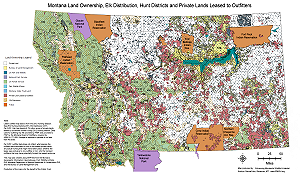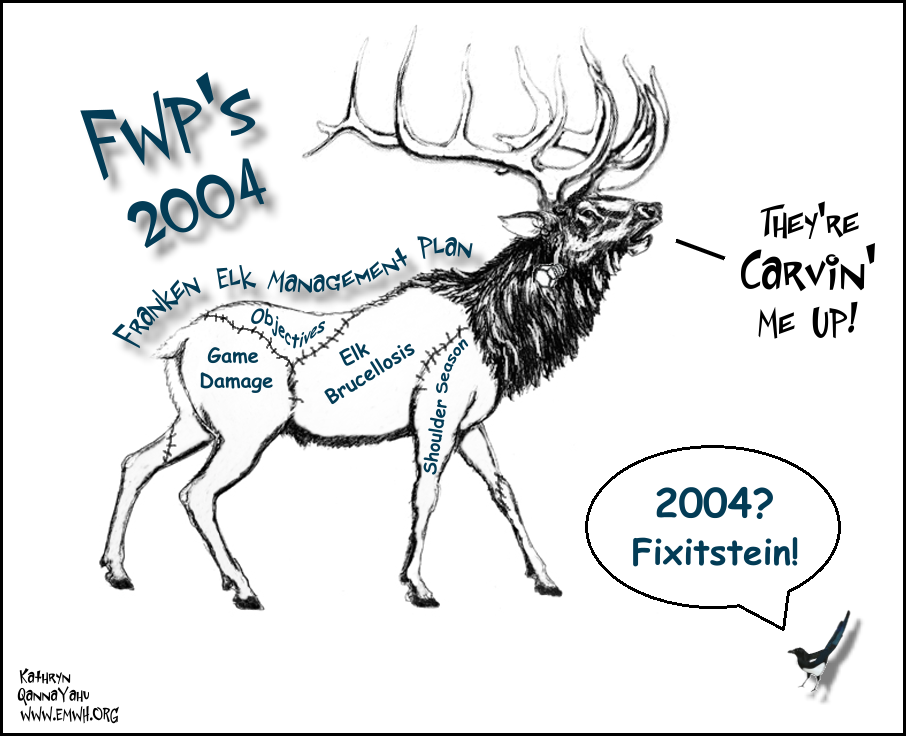MT FWP Elk
Shoulder Season Proposal

Breakdown
of why FWP has not supplied the FWP Commissioners or the Public
enough biological, statistical & implemented legal procedural
data to justify an elk shoulder season below, especially if combined
with their Game Damage Amendment Proposal legal "cover our
asses" for all their violations they have been committing
(towards the bottom). They need to legally follow the regulations,
and implement what is already on the books, before they change
anything. |
Public
Comments due to FWP Commissioners by 5PM on Aug. 28th
(we just petitioned for an extension and received one to Aug. 28th)
please contact to object to the Elk Shoulder Seasons Proposals.
Montana Public/Private
Land Ownership, Elk Population Distribution, Hunt Districts
|
ArcGIS map of Public/Private
Land Ownership, Elk Population Distribution, Hunt Districts
FWP
2014 Objective/Winter Counts Chart PDF |
| FWP states, "These guidelines were developed for improved elk harvest management resulting in more elk populations being at objective." There are a number of questions and concerns about the FWP elk harvest management and objectives that need to addressed (below). FWP then goes on to define "A 'shoulder season'. What they dont tell you:
The information below expands the above bullet points, with the exposing documentation of what the hell has been undermining our Montana Statewide Elk Management Plan. Public Comments due to FWP Commissioners by 5PM on Aug. 28th (we just petitioned for an extension and received one to Aug. 28th) - please contact to object to the Elk Shoulder Seasons Proposals. |
|
First and foremost is the 2004 Montana Statewide Elk Managment Plan This elk plan was last published in 2004. There are a number of components to it that are outdated and need to be revised- this requires an Environmental Impact Study (EIS) - you know... the scientific evidence our wildlife are supposed to be managed by! At the June 11th FWP Commission meeting (audio), when the elk shoulder seasons was rolled out by Quentin Kujula, Commissioner Tourtelotte asked Kujula about revising the older elk plan to get it up to date. Kujula answered that it would take about 18 months to do so. In my public comments I pointed out that 2 years ago, myself and a number of conservation hunters began asking the Commission to direct FWP to do an EIS and update the outdated 2004 Elk Plan. If FWP had done so at that time, we would already have a current elk plan, instead of all these patch jobs (elk brucellosis program, game damage, elk shoulder seasons, faulty objectives) creating a Frankenstein elk management plan. |
Click image for full size |
Objective Numbers Not all the objective numbers are based on the regulations of "habitat", instead of politics and special interest greed that would privatize our elk populations have caused artificially low objectives to force an "above objective" situation, thereby increasing the number of tags issued, especially in areas with landowner lands outfitted or landowner leased lands to outfitters. Often access to nearby federal or state public lands has been cut off. Additionally, much has changed on the landscape that has altered the previous landowner base, predator landscape, scientific understanding of the elk habitat forage needs in relation to recruitment, roadless areas habitat security, etc. A review and updating of the "objective" process within a new Elk Management Plan EIS is necessary. Montana
Code Annotated 87-1-323 states : Viable elk, deer, and antelope
populations based on habitat acreage -- reduction
of populations as necessary. (1) Based on the habitat acreage that
is determined pursuant to 87-1-322, the commission shall determine
the appropriate elk, deer, and antelope numbers that can be viably
sustained. The department shall consider the specific concerns of
private landowners when determining sustainable numbers pursuant
to this section. Elk Management Plan Page 55 - Harbored/Refuge Elk not counted In the section - Establishing Number Objectives for Elk, 5. "Elk populations in portions of some EMU's (Elk Managment Units) may be almost entirely inaccessible to hunters during the general hunting season or accessible to only a few hunters. To avoid over-harvest of accessible elk on public lands or private lands open to hunting, the inaccessible elk may not be included in objective numbers. Trend count number objectives may include only elk normally accessible to general hunting (if they are a distinct segment), though hunter access negotiations will continue. Elk occupying these 'refuges' may be counted separately where practical (if they are a distinct segment) and sub-objectives established that could be operative if access negotiations are successful. If significant harvest of these 'refuge' elk is possible with special managmeent at some times and locations, they should be included in objective levels." This sub-objectives process needs to be implemented in elk conversation in Montana, based on scientific evidence, not politics. I had been asking for years if this has ever been utilized. Again, at this June's Commission meeting, where they rolled out this elk shoulder season proposal, I read this section to the commissioner and asked again. Thankfully, a hunter listening to the livestream of the meeting heard and knew who I was, contacted me with what they had done for their HD 270 - documents and explanation below. Hunters fight to exclude harbored elk counts on private lands from overall elk count in HD 270 Hunters with the Ravalli County Fish & Wildlife, seeing pg. 55 of the Elk Plan, to exclude refuge/harbored elk from the elk count applied to the objectives, pursued this application with their local Region 2 wildlife biologists. They began this discussion about 2003, it took time, persistence and they had to pay for an aerial flight with their own money to prove to FWP that there were consistently hundreds of harbored elk on the nearby CB Ranch (that should not have been necessary), causing their HD 270 to artificially appear over-objective. The increased tags issued, to bring the population at/under objective, then began decimating the elk population available on the public lands. Finally, FWP presented to the FWP Commissioners the request, per point no. 5, page 55 of the elk plan, to remove the 800 "refuge" elk from the count. The Commissioners approved the motion to establish a sub-objective of 2600 for publicly accessible elk for HD 270 on September 25, 2008. HD 270 remains "At" objective as a result. "With knowledge of this elk count on the CB Ranch, members of the Ravalli County Fish & Wildlife Association expressed concerns about FWP's continued efforts to bring the elk population in HD 270 to a level that would be at or below objective by January 2009, as now directed by statute. The concern was expressed that if FWP did not adjust its harvest strategy, only elk herd-units on public land or accessible private land would be reduced. These are the only elk that contribute to public hunting recreation: therefore, elk numbers on private refugia continue increasing. FWP recognizes that elk herd-units in HD 270, which are accessible to public hunting harvest, will be overharvested to the detriment of the public trust if a harvest strategy is employed that is blind to the existence of a large elk 'refuge' in its approach toward reaching an objective of 3,000. If elk continue to increase on the 'refuge,' then the publicly accessible elk must continually decrease to stay at or below objective. Clarification of the guidance on page 55 of the Elk Plan is needed to bring FWP and interested parties together on a harvest strategy that all can agree is intended and effective under the Elk Plan." PDF of HD270 "refuge" elk documents provided by Ravalli County Fish & Wildlife Game Damage Interconnections As a conservation hunter, having attended the Paradise Valley Elk Brucellosis Working Group meetings, taking audio at eachmeeting, in the fall/winter of 2013/2014, I heard many a rancher complain about the elk numbers, one county commissioner stating you should be able to kill elk anytime, wanting our sportsmen's dollars for actions/materials similar to game damage, but without any required pubic hunter access in return. This area is hevily outfitted and does not participate in Block Management. I was curious about game damage complaints, hearing all the complaints and statements that game damage doesnt work and called Region 3 to get a summary. I was told they did not have the data, to call Helena. When I spoke with Helena, I was told it would have to be compiled, as they had not done that before. I requested Region 3 and specifically Park County from 2007-2012 (the year that this illegal elk brucellosis program began, bypassing teh legal game damage program). The results were that from 2007-2012, 6 years, there were only 5 elk game damage complaints for all of Park County, some years having none. Concerning the legislative audit of the game damage program below, there may be more to this picture.
Legislative Game Damage Performance Audit Request This legislative audit was requested
by Rep. Errol Wylie Galt (one of the largest landowners [co-owner]
in Montana - 71 Ranch LP) during the 2013 legislative session.
Interestingly, there was a petition with about 54 legislators signatures
requesting this audit. One of the main points for this audit states:
This is about using sportsmen's dollars to supply game damage actions/materials, on some private lands that are ineligible due to outfitting and allowing those special interest landowners/outfitters to bypass the established public hunt roster and supply the hunters they want (clients?). Reviewing a number of landowner outfitted websites you see a pattern in their advertising of a limited number of hunts/hunters allowed on the landscape in a season - they want to increase the herd and its quality to be able to charge more per unit, generally for large bull elk. This creates a privatized "harboring' or "refuge" situation also increasing the amount of cow elk on the landscape, which they want limited - hence the game damage for the cows/antlerless. Legislative Audit - FWP Game Damage Performance This subject is interconnected with the Elk Shoulder Season as yet another attempt to privatize our public elk herds for the benefit of some greedy landowners and outfitters. Not all landowners and/or outfitters seek to privatize our wildlife. Game Damage Audit Overview Page provides bullet points of the worst of the violation examples in the 56 page audit. Some of these examples involve 82 percent of game damage complaint files had missing or incomplete complaint forms or landowner eligibility worksheets; landowners receiving sportsmen's dollars assistance without being eligible; $2000-$2600 avg. stack fencing provided without evidence of game damage; very little supervisory oversight and responsibility for game damage program statewide; FWP creating unregulated illegal hybrid process instead of following MCA and ARM on game damage; established and democratic public hunt roster being ignored with some landowners choosing the hunters they want on their land; materials not being purchased by required contrators, little accountability of materials and their dispersal; illegal issuance of explosive cracker shells to landowners without ATF permit, as well as other ammunition; etc. Legislative Perfomance Audit - FWP Game Damage Program, May 2015, 56 pages The whole reason for this FWP Elk Shoulder Season proposal is stated in the Background information, first paragraph, "This was in response to Gov. Bullock's charge to improve landowner relations and specifically in response to criticism that FWP was not meeting elk objectives." As mentioned above, not all elk objectives are set by the legal mandate of habitat, some have been solely based on landowners opinions. The outfitter connection comes in when a landowner outfits their own land, or leases their land to an outfitter. If they have a vested and commercial interest in high elk populations, with low objectives, this increases the amount of permits for an area, even areas being listed as unlimited. This Outfitter Connection page documents some of the landowner and landowner leased outfitter connections to the elk populations in a handful of hunt districts listed as over objective.
|
Research by Kathryn QannaYahu

Site designed and maintained by Kathryn QannaYahu
|
|
|
|








